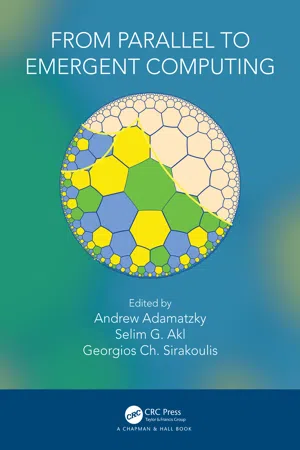
- 608 pages
- English
- ePUB (mobile friendly)
- Available on iOS & Android
From Parallel to Emergent Computing
About This Book
Modern computing relies on future and emergent technologies which have been conceived via interaction between computer science, engineering, chemistry, physics and biology. This highly interdisciplinary book presents advances in the fields of parallel, distributed and emergent information processing and computation. The book represents major breakthroughs in parallel quantum protocols, elastic cloud servers, structural properties of interconnection networks, internet of things, morphogenetic collective systems, swarm intelligence and cellular automata, unconventionality in parallel computation, algorithmic information dynamics, localized DNA computation, graph-based cryptography, slime mold inspired nano-electronics and cytoskeleton computers.
Features
- Truly interdisciplinary, spanning computer science, electronics, mathematics and biology
-
- Covers widely popular topics of future and emergent computing technologies, cloud computing, parallel computing, DNA computation, security and network analysis, cryptography, and theoretical computer science
-
- Provides unique chapters written by top experts in theoretical and applied computer science, information processing and engineering
-
From Parallel to Emergent Computing provides a visionary statement on how computing will advance in the next 25 years and what new fields of science will be involved in computing engineering. This book is a valuable resource for computer scientists working today, and in years to come.
Frequently asked questions
Information
Table of contents
- Cover
- Half-Title
- Title
- Copyright
- Contents
- Preface
- Editor Bios
- Contributors
- Editorial Boards of the International Journal of Parallel, Emergent and Distributed Systems
- Part 1 Networks and Parallel Computing
- Part 2 Distributed Systems
- Part 3 Emergent Computing
- Index